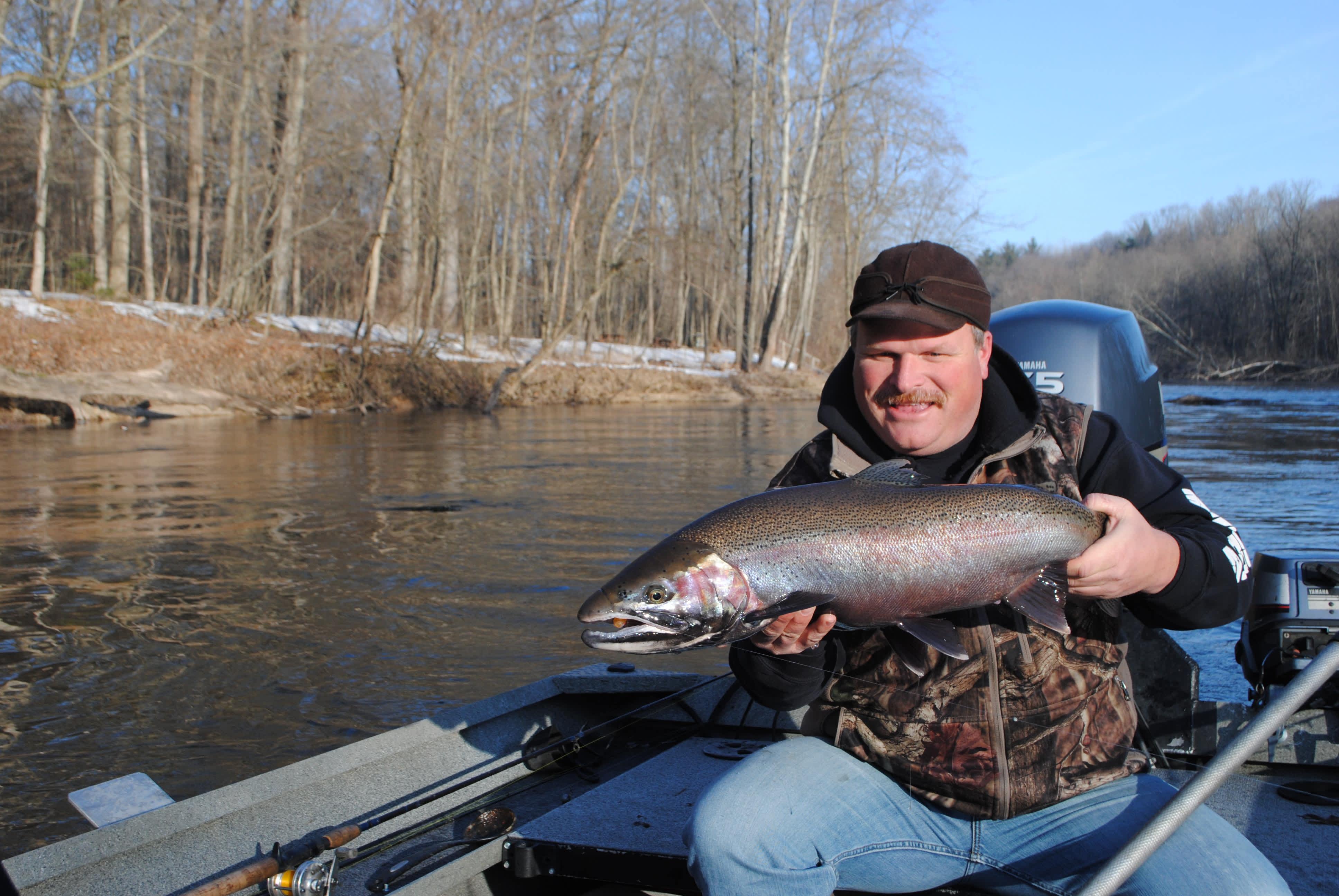Walking Spawn for Steelhead in Michigan’s Muskegon River
Bob Gwizdz 05.09.13

Denny Bouwens said he had it figured out well in advance. We’d have to be on the Muskegon River early, because boat traffic was likely to be significant. And because the water was higher than it had been–and likely to be colored up–we’d have to get the bait down.
So when we started, we were doing something I’d never done before: walking spawn while Bouwens ran a kicker outboard to keep us slowly slipping downstream.
I’ve walked spawn plenty of times, but always from a stationary position. It was a learning process, but it didn’t take long. Fifteen minutes into it, Bouwens brought a colorful steelhead (four- to five-pound range) to the net.
“It’s our go-to presentation when the water is high and dingy,” Bouwens explained. “It’s a unique method and you’re moving around so much you cover a lot of water. You find a biter, catch him, go back up and do it again.”
We went back, but didn’t catch another fish. So we moved downstream, to the next run, and Bouwens caught one there, too.
“You don’t catch every fish in the hole,” Bouwens said. “You’re not fishing it thoroughly. You’re just catching the aggressive fish.”
The keys, Bouwens said, are big bags–and we were using spawn bags the size of ping-pong balls–and keeping the bait down near bottom. Bouwens tied his bags with some small foam floaters in them, he said, so the bags were just a couple of inches off the bottom.
“Right at chin level,” he said. “Right in their face.”
At our next stop, the current was a bit slower so while Bouwens and his buddy Justin Welch continued walking spawn, I grabbed a bobber rod. The sun was just clearing the trees, but we were still fishing in the shade. On my third drift, the bobber went down and I slammed the hook home. It was a beauty–a big, colored hook-jawed buck that would easily weigh double digits. I checked my watch: it was 9 a.m.
As we worked our way downstream, Bouwens and his buddy set up a hypothetical milk run of holes we’d hit. It wasn’t–virtually every hole we approached had a boat anchored above it. We hit some holes that we wouldn’t have fished if it hadn’t been so crowded, to no avail, by which time the sun had climbed pretty high in the sky and the bite slowed down.
“Glad we got started early,” Bouwens said.
We hit a long deep run that Bouwens had been salivating over. Finally, toward the end of the run, Bouwens hit another fish, a bright female. It gobbled up his spawn bag not too far from the prop wash.
“I think the fish pick out that bigger spawn bag better when the water‘s high and there’s more scent in the water with a bigger bag,” he said. “It’s a technique that not everyone can pick up right away. You’ve got to stick with it. It’s like jigging for steelhead.”
The idea is to cast the bait out, then lift the sinker off the bottom, let a little line slip, pick it up again, repeat. Ideally, you can keep the spawn bag about the same distance from the boat as you slip downstream. It doesn’t have to be way out there.

“When the water’s dingy, the boat doesn’t bother them,” Bouwens said. “The motor doesn’t bother them.”
Fact is, there’s a school of thought that the motor actually helps. Wakes ‘em up. Gets ‘em moving around.
We were using baitcasting reels, which are a lot easier to walk with as your thumb controls the line, rather than opening and closing the bail on a spinning reel. Bouwens had a 36-inch leader of 10-pound fluorocarbon line below a swivel with the sinker on a snap just above the swivel. He uses heavier leaders than many would because “there’s a lot of lumber in here,” he said.
Using the right weight sinker is key. You need more weight in deeper, faster-running water, less in shallower or slower water. We started out with 3/4-ounce sinker in the first runs, but downsized to 1/2-ounce weights in runs with less current.
In one particularly deep hole, Bouwens caught another nice ‘head, a fish he maintained we couldn’t have caught that last fish had we been fishing with bobbers.
“You can use a bobber around the back water or around the brush, but it’s pretty hard to fish a bobber in 12 feet of water,” he said.
Personally, I stayed with the bobber (don’t fix what ain’t broke, eh?) and at 11 a.m., I hit another fish. This was chrome hen–“a lightning bolt” is how Bouwens put it–in the eight- or nine-pound class. A beauty.
We turned around and headed back upstream, hitting some of the holes that had been vacated since we worked our way downstream. No dice. We fished for three more hours and never landed another fish.
That figures; a high sky can make for a tough bite.
I was pretty pleased. We’d landed five and had a couple of other bites. Had we started at mid-morning, it might have been entirely different.
Welch, who is a devotee of back-walking spawn, said I really didn’t get a good taste of the technique.
“It can be stupid when the bite’s on,” he said. “And it can be a lot like plugging; about 90 percent of the time, the fish you catch are in the bottom of the hole. It’s like you’re backing them down until they hit, like plugging with a spawn bag as far as I’m concerned.”
I’d love to do some more of it. But with spring fast approaching, it won’t be long until the steelhead are all up on the redds and 95 percent of the fishing will be rolling span bags or flies across the gravel.
Oh, well, there’s always next year.
For more information on Michigan fishing go to michigan.org.

